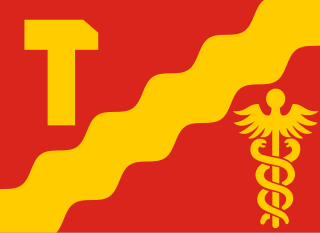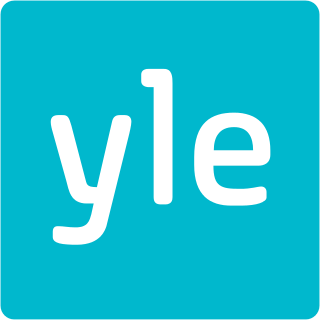
Tampere is a city in Finland and the regional capital of Pirkanmaa. It is located in the Finnish Lakeland. The population of Tampere is approximately 255,000, while the metropolitan area has a population of approximately 417,000. It is the 3rd most populous municipality in Finland, and the second most populous urban area in the country after the Helsinki metropolitan area.

Yleisradio Oy, abbreviated as Yle, translated into English as the Finnish Broadcasting Company, is Finland's national public broadcasting company, founded in 1926. It is a joint-stock company, which is 99.98% owned by the Finnish state and employs around 3,200 people in Finland. Yle shares many of its organisational characteristics with its British counterpart, the BBC, on which it was largely modelled.

MTV3 is a Finnish commercial television channel owned and operated by the media company MTV Oy, originally launched in 13 August 1957 as a programming block, becoming its own channel on 1 January 1993. It had the biggest audience share of all Finnish TV channels until Yle TV1 took the lead. MTV actually stands for Mainos-TV, due to the channel carrying advertising for revenue. Number 3 was added later, when the channel was allocated the third nationwide television channel and it generally became known as "Channel Three"—Finnish Broadcasting Company's Yle TV1 and Yle TV2 being the first two—and also to distinguish it from the later MTV Finland, which is a Finnish version of Paramount's MTV channel. From 1957 until 2001, the channel's logo was a stylised owl, changed to an owl's eye after an image renewal in 2001, which was then used until 2013. MTV3 has about 500 employees. It is also known as Maikkari. From 1986 to 1993, Kolmoskanava was a precursor to MTV3. It was shut down at midnight on December 31, and MTV3 immediately started broadcasting.

Television was introduced in Finland in 1955. Color television started in 1969 and was introduced gradually, with most programs in color by the late 1970s. All terrestrial analogue stations stopped broadcasting on 1 September 2007 after the introduction of digital television; cable providers were allowed to continue analog broadcasting in their networks until 1 March 2008.

Yle TV1 is a Finnish television channel owned and operated by Finnish public broadcaster Yle. It is the second oldest and the oldest existing television channel in Finland. More than 70% of the channel's programs are documentaries, news, or educational programmes. Its name is commonly referred to as Ykkönen; it derives from Yle's ownership of channels Spots 1 and 2 by default in Finland; the other, spot 2 channel, is Yle TV2.

Yle TV2 is a Finnish television channel owned and operated by Yle. TV2 was launched in 1965 as the successor to the former television channels TES-TV (Tesvisio) and Tamvisio, and broadcasts public service programming, sports, drama, children's, youth, and music programmes. With Yle TV1, it is one of the three main television channels of Yle.
Finland participated in and won the Eurovision Song Contest 2006 with the song "Hard Rock Hallelujah" written by Mr Lordi. The song was performed by the band Lordi. The Finnish broadcaster Yleisradio (Yle) organised the national final Euroviisut 2006 in order to select the Finnish entry for the 2006 contest in Athens, Greece. 12 artists with two songs each were selected to compete in the national final, which consisted of four semi-finals and a final, taking place in February and March 2006. Twelve entries ultimately competed in the final on 10 March where votes from the public selected "Hard Rock Hallelujah" performed by Lordi as the winner.
Finland participated in the Eurovision Song Contest 2005 with the song "Why?" written by Mika Toivanen and Steven Stewart. The song was performed by Geir Rönning. The Finnish broadcaster Yleisradio (Yle) organised the national final Euroviisut 2005 in order to select the Finnish entry for the 2005 contest in Kyiv, Ukraine. 24 entries were selected to compete in the national final, which consisted of four semi-finals and a final, taking place in January and February 2005. Six entries competed in each semi-final and the top three from each semi-final, as selected solely by a public vote, advanced to the final. Twelve entries competed in the final on 19 February where votes from six regional juries first selected the top six to advance to a second round. In the second round, votes from the public selected "Why?" performed by Geir Rönning as the winner with 30,648 votes.
Finland participated in the Eurovision Song Contest 2007 with the song "Leave Me Alone" written by Martti Vuorinen and Miikka Huttunen. The song was performed by Hanna Pakarinen. In addition to participating in the contest, the Finnish broadcaster Yleisradio (Yle) also hosted the Eurovision Song Contest after winning the competition in 2006 with the song "Hard Rock Hallelujah" performed by Lordi. Yle organised the national final Euroviisut 2007 in order to select the Finnish entry for the 2007 contest in Helsinki. 12 artists with two songs each were selected to compete in the national final, which consisted of four semi-finals and a final, taking place in January and February 2007. Twelve entries ultimately competed in the final on 17 February where votes from the public selected "Leave Me Alone" performed by Hanna Pakarinen as the winner.
Finland participated in the Eurovision Song Contest 2002 with the song "Addicted to You" written by Maki Kolehmainen, Janina Frostell and Tracy Lipp. The song was performed by Laura. The Finnish broadcaster Yleisradio (Yle) returned to the Eurovision Song Contest after a one-year absence following their relegation from 2001 as one of the bottom six countries in the 2000 contest. Yle organised the national final Euroviisut 2002 in order to select the Finnish entry for the 2002 contest in Tallinn, Estonia. Twelve entries were selected to compete in the national final on 26 January 2002 where votes from six regional juries first selected the top six to advance to a second round. In the second round, votes from the public selected "Addicted to You" performed by Laura as the winner with 70,580 votes.
Finland participated at the Eurovision Song Contest 2008 with the song "Missä miehet ratsastaa" written by Jarkko Ahola. The song was performed by the band Teräsbetoni. The Finnish broadcaster Yleisradio (Yle) organised the national final Euroviisut 2008 in order to select the Finnish entry for the 2008 contest in Belgrade, Serbia. 12 entries were selected to compete in the national final, which consisted of three semi-finals, a Second Chance round and a final, taking place in February and March 2008. Eight entries ultimately competed in the final on 1 March where votes from the public selected "Missä miehet ratsastaa" performed by Teräsbetoni as the winner.
Talent Suomi is the Finnish version of the Got Talent format of the program and airs on Nelonen. The idea behind the programme is to search for the most talented and promising entertainment. Talent contest took off for the first time in Finland at the end of September 2007. The programme was originally hosted by Susanna Laine and Martin Coulter and had contemporary magazine editor Katja Ståhl, television presenter and film director Timo Koivusalo, as well as the Finnish National Ballet dancer and choreographer Sami Saikkonen as judges. The prize was €30,000.
Finland participated in the Eurovision Song Contest 2004 with the song "Takes 2 to Tango" written by Mika Toivanen and Jari Sillanpää. The song was performed by Jari Sillanpää. The Finnish broadcaster Yleisradio (Yle) returned to the Eurovision Song Contest after a one-year absence following their relegation from 2003 as one of the bottom five countries in the 2002 contest. Yle organised the national final Euroviisut 2004 in order to select the Finnish entry for the 2004 contest in Istanbul, Turkey. 20 entries were selected to compete in the national final, which consisted of two semi-finals and a final, taking place in January 2004. Ten entries competed in each semi-final and the top six from each semi-final, as selected solely by a public vote, advanced to the final. Twelve entries competed in the final on 24 January where votes from six regional juries first selected the top six to advance to a second round. In the second round, votes from the public selected "Takes 2 to Tango" performed by Jari Sillanpää as the winner with 98,987 votes.
Finland participated at the Eurovision Song Contest 2010 with the song "Työlki ellää" written by Timo Kiiskinen. The song was performed by the duo Kuunkuiskaajat. The Finnish broadcaster Yleisradio (Yle) organised the national final Euroviisut 2010 in order to select the Finnish entry for the 2010 contest in Oslo, Norway. 15 entries were selected to compete in the national final, which consisted of three semi-finals and a final, taking place in January 2010. Ten entries ultimately competed in the final on 30 January where votes from the public selected "Työlki ellää" performed by Kuunkuiskaajat as the winner.
Finland participated in the Eurovision Song Contest 2011 with the song "Da Da Dam" written by Axel Ehnström. The song was performed by Paradise Oskar, which is the artistic name of singer Axel Ehnström. The Finnish broadcaster Yleisradio (Yle) organised the national final Euroviisut 2011 in order to select the Finnish entry for the 2011 contest in Düsseldorf, Germany. 15 entries were selected to compete in the national final, which consisted of three semi-finals and a final, taking place in January and February 2011. Ten entries ultimately competed in the final on 12 February where votes from the public selected "Da Da Dam" performed by Paradise Oskar as the winner.

Erkki Pohjanheimo is a Finnish television producer and director.

Wendla Irene Soldan-Brofeldt, known as Venny was a Finnish painter, illustrator, graphic artist, wood sculptor and jewelry designer. She belonged to the Swedish speaking population of Finland.

The Independence Day Reception is an annual event organised by the President of Finland at the Presidential Palace in Helsinki on 6 December, Finland's Independence Day. Invitations are sent to all members of parliament and other representatives of the national and municipal governments, the ambassadors to Finland, representatives of NGOs, important business people, and people who distinguished themselves during the year in the arts, sports, sciences, and other fields.

Pekka Heikki Tapani Gronow is a Finnish ethnomusicologist and historian of the recording industry. He studied at Wesleyan University with David P. McAllester and Robert E. Brown and at the University of Helsinki and received his PhD from the University of Tampere. He was the head of the record library at Yleisradio 1989–2006 and an archiving specialist 2007–2008. Gronow became known in the 1960s for his radio programs on jazz and blues. In 1966 he founded with M. A. Numminen Eteenpäin, a record company which issued Numminen's works and other underground artists.
Irja Johanna “Jonna” Järnefelt is a Finnish actress and singer.










